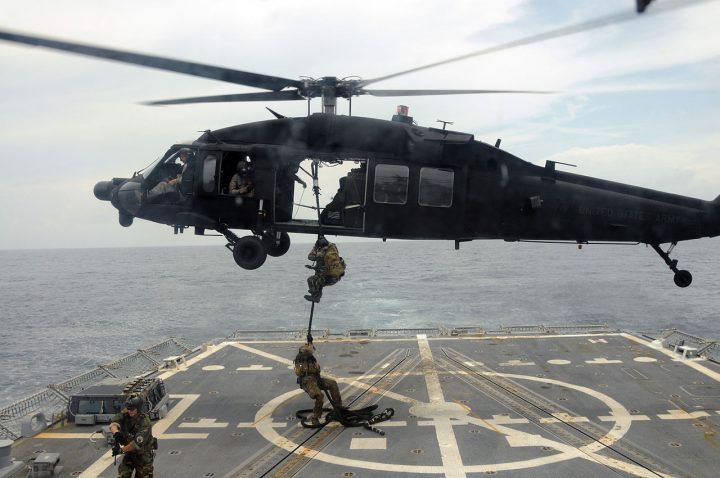Total world military expenditure rose to $1686 billion in 2016, an increase of 0.4 per cent in real terms from 2015, according to new figures from the Stockholm International Peace Research Institute (SIPRI). Military spending in North America saw its first annual increase since 2010, while spending in Western Europe grew for the second consecutive year. The comprehensive annual update of the SIPRI Military Expenditure Database is accessible from today at www.sipri.org.
The USA’s spending returns to growth; Saudi Arabia’s spending falls significantly
The United States remains the country with the highest annual military expenditure in the world. US military spending grew by 1.7 per cent between 2015 and 2016 to $611 billion. Military expenditure by China, which was the second largest spender in 2016, increased by 5.4 per cent to $215 billion, a much lower rate of growth than in previous years. Russia increased its spending by 5.9 per cent in 2016 to $69.2 billion, making it the third largest spender. Saudi Arabia was the third largest spender in 2015 but dropped to fourth position in 2016. Spending by Saudi Arabia fell by 30 per cent in 2016 to $63.7 billion, despite its continued involvement in regional wars. India’s military expenditure grew by 8.5 per cent in 2016 to $55.9 billion, making it the fifth largest spender.
The growth in US military expenditure in 2016 may signal the end of a trend of decreases in spending, which resulted from the economic crisis and the withdrawal of US troops from Afghanistan and Iraq. US spending in 2016 remained 20 per cent lower than its peak in 2010. ‘Despite continuing legal restraints on the overall US budget, increases in military spending were agreed upon by Congress,’ said Dr Aude Fleurant, Director of the SIPRI Arms and Military Expenditure (AMEX) programme. ‘Future spending patterns remain uncertain due to the changing political situation in the USA.’
Increases in Europe linked to growing threat perceptions
Military expenditure in Western Europe rose for the second consecutive year and was up by 2.6 per cent in 2016. There were spending increases in all but three countries in Western Europe. Italy recorded the most notable increase, with spending rising by 11 per cent between 2015 and 2016.
The countries with the largest relative increases in military spending between 2015 and 2016 are in Central Europe. Overall spending in Central Europe grew by 2.4 per cent in 2016. ‘The growth in spending by many countries in Central Europe can be partly attributed to the perception of Russia posing a greater threat,’ said Siemon Wezeman, Senior Researcher with the SIPRI AMEX programme. ‘This is despite the fact that Russia’s spending in 2016 was only 27 per cent of the combined total of European NATO members.’
Large falls in military expenditure in many oil-exporting countries
‘Falling oil revenue and associated economic problems attached to the oil-price shock has forced many oil-exporting countries to reduce military spending,’ said Dr Nan Tian, Researcher with the SIPRI AMEX programme. ‘For example, between 2015 and 2016 Saudi Arabia had the biggest absolute decrease in spending of $25.8 billion.’
The largest cuts in military expenditure in 2016 related to falling national oil revenues were in Venezuela (–56 per cent), South Sudan (–54 per cent), Azerbaijan (–36 per cent), Iraq (–36 per cent) and Saudi Arabia (–30 per cent). Other notable decreases were seen in Angola, Ecuador, Kazakhstan, Mexico, Oman and Peru. Only 2 of the 15 countries with the largest falls in spending in 2016 are not oil exporters. However, a minority of oil-exporting countries, such as Algeria, Iran, Kuwait and Norway, are better equipped economically to deal with oil-price shocks and could continue with their existing spending plans in 2016.
Other notable developments
• World military spending in 2016 accounted for 2.2 per cent of global GDP. Military spending as a share of GDP, was highest in the Middle East (for countries where data is available), with an average of 6.0 per cent of GDP in 2016, while the lowest was in the Americas, with an average of 1.3 per cent of GDP.
• Spending in Africa fell by 1.3 per cent in 2016, a second year of decrease after 11 consecutive years of increases. This was mostly due to spending cuts in oil-exporting countries in sub-Saharan Africa (e.g. Angola and South Sudan).
• In Asia and Oceania, military expenditure rose by 4.6 per cent in 2016. Spending levels are related to the many tensions in the region such as over territorial rights in the South China Sea.
• Military expenditure in Central America and the Caribbean and South America combined decreased by 7.8 per cent to a level not seen since 2007. The fall is largely explained by spending reductions by oil-exporting countries such as Ecuador, Mexico, Peru and Venezuela. Brazil’s spending continued to decline as a result of a worsening economic crisis.
• There is no estimate for the Middle East as data is unavailable for several key spenders such as the United Arab Emirates. For countries where data is available, substantial increases were seen in Iran and Kuwait, while sizable decreases were noted in Iraq and Saudi Arabia.










